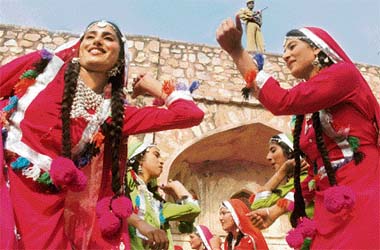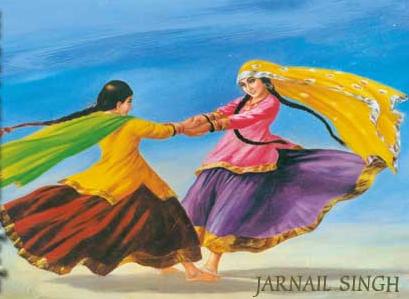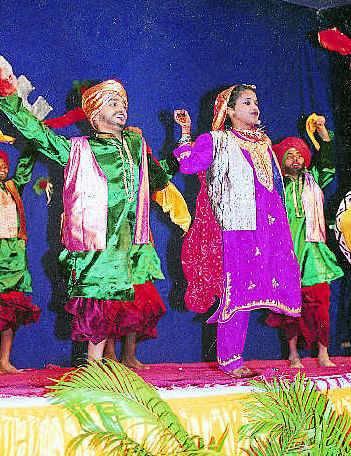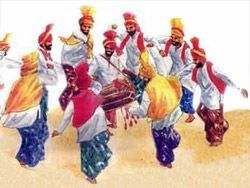$un$hyn
hIs )..Prince$$..(
SAMMI
This is a popular dance of Sandal Bar. This is a women's dance and like the Giddha it is danced in a circle. The dancers stand in a ring and swing their hands bringing them up from the sides, right in front, up to the chest and clap. They take the hands down in accordance with a rhythm and a system and clap again. Repeating this gesture, they bend forward and clap again and go round and round in a circle, as the rhythm is maintained with the beat of the feet. Various kinds of swinging movements are performed with the arms. This is a very simple dance. Most of the gestures and confined to the movements of the arms, clicking and clapping. No instrument is required as an accompaniment to this dance. Rhythm is kept up with the beating of feet and clapping. The dance is named after the young heroine of a legend, Sammi, who was madly in love and used to sing and dance as best she could for the sake of her lover.

KIKLI
Kikli is generally popular with the younger girls. They form pairs and then the two girls of each pair stand opposite each other holding each other's hands crosswise. Then they lift their heels and swing round and round on their toes. The movements gets faster and faster, the upper part of the body bends backward and the arms remain fully stretched. As the spinning gathers momentum, it creates an ecstasy and the girls go on and on till they reach the point of exhaustion. Even though they move very fast, they are very careful to maintain rhythm and keep singing various kinds of songs about the mother, the father, the brother, the mother-in-law and about various incidents connected with daily life.

Luddi and Jhumar are also famous dances especially for auspicious occasions. Luddi is generally danced to celebrate a victory. Dancers lift both arms, hop on one foot and move in a circle, swinging their bodies and shaking their shoulders. Though no songs are sung with Luddi, it is a dance bursting with enthusiasm.
JHUMAR
The Jhumar is a folk dance of the harvest season. Although it shares many features with the Bhangra, it can be clearly distinguished from the latter on account of its thematic content and its emphasis on recreating the gaits of animals and birds. In the Bhangra, there is not attempt to show the movements of sowing and reaping the harvest; in the Jhumar all the functions of daily life are recreated and the pairs of dancers who come into the central area, often imitate the movements of the animals they rear. Two men become bullocks of the field, a third plough and the fourth a farmer. The gaits of the animals, the ploughing of the field, sowing of the seeds and harvesting are shown step by step. The crops are cut and then the dancers again rejoin into a circle and dance very much in the manner as of the Bhangra.
KARTHI
Karthi is the only mixed dance of men and women, which used to be more popular in the hills, than in the plains. While the Bhangra and the Jhumar are not preceded by any ritual to a deity, in the Karthi, offerings are first made to a deity, at a harvest time. This is followed by women leading the processions and singing songs. The men follow, and then a circle is formed with men and women alternating and linking hands. The accompanying songs are sentimental, and tell of battles fought and victories won, of the union and quarrels of lovers. The tempo of the Karthi is a slower than the tempo of the other two dances. There is much clapping of hands both singly and in pairs. While no wind instruments are used in the Bhangra and the Jhumar, a folk Shenai and other wind instruments are in evidence in the Karthi.

This is a popular dance of Sandal Bar. This is a women's dance and like the Giddha it is danced in a circle. The dancers stand in a ring and swing their hands bringing them up from the sides, right in front, up to the chest and clap. They take the hands down in accordance with a rhythm and a system and clap again. Repeating this gesture, they bend forward and clap again and go round and round in a circle, as the rhythm is maintained with the beat of the feet. Various kinds of swinging movements are performed with the arms. This is a very simple dance. Most of the gestures and confined to the movements of the arms, clicking and clapping. No instrument is required as an accompaniment to this dance. Rhythm is kept up with the beating of feet and clapping. The dance is named after the young heroine of a legend, Sammi, who was madly in love and used to sing and dance as best she could for the sake of her lover.

KIKLI
Kikli is generally popular with the younger girls. They form pairs and then the two girls of each pair stand opposite each other holding each other's hands crosswise. Then they lift their heels and swing round and round on their toes. The movements gets faster and faster, the upper part of the body bends backward and the arms remain fully stretched. As the spinning gathers momentum, it creates an ecstasy and the girls go on and on till they reach the point of exhaustion. Even though they move very fast, they are very careful to maintain rhythm and keep singing various kinds of songs about the mother, the father, the brother, the mother-in-law and about various incidents connected with daily life.

Luddi and Jhumar are also famous dances especially for auspicious occasions. Luddi is generally danced to celebrate a victory. Dancers lift both arms, hop on one foot and move in a circle, swinging their bodies and shaking their shoulders. Though no songs are sung with Luddi, it is a dance bursting with enthusiasm.
JHUMAR
The Jhumar is a folk dance of the harvest season. Although it shares many features with the Bhangra, it can be clearly distinguished from the latter on account of its thematic content and its emphasis on recreating the gaits of animals and birds. In the Bhangra, there is not attempt to show the movements of sowing and reaping the harvest; in the Jhumar all the functions of daily life are recreated and the pairs of dancers who come into the central area, often imitate the movements of the animals they rear. Two men become bullocks of the field, a third plough and the fourth a farmer. The gaits of the animals, the ploughing of the field, sowing of the seeds and harvesting are shown step by step. The crops are cut and then the dancers again rejoin into a circle and dance very much in the manner as of the Bhangra.
KARTHI
Karthi is the only mixed dance of men and women, which used to be more popular in the hills, than in the plains. While the Bhangra and the Jhumar are not preceded by any ritual to a deity, in the Karthi, offerings are first made to a deity, at a harvest time. This is followed by women leading the processions and singing songs. The men follow, and then a circle is formed with men and women alternating and linking hands. The accompanying songs are sentimental, and tell of battles fought and victories won, of the union and quarrels of lovers. The tempo of the Karthi is a slower than the tempo of the other two dances. There is much clapping of hands both singly and in pairs. While no wind instruments are used in the Bhangra and the Jhumar, a folk Shenai and other wind instruments are in evidence in the Karthi.


